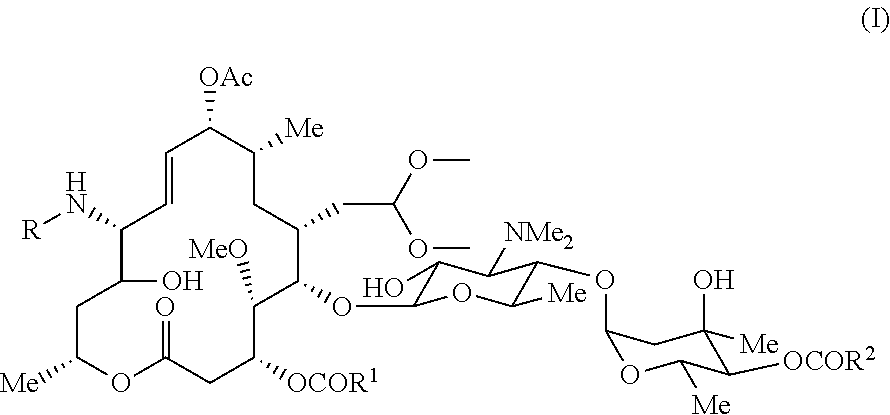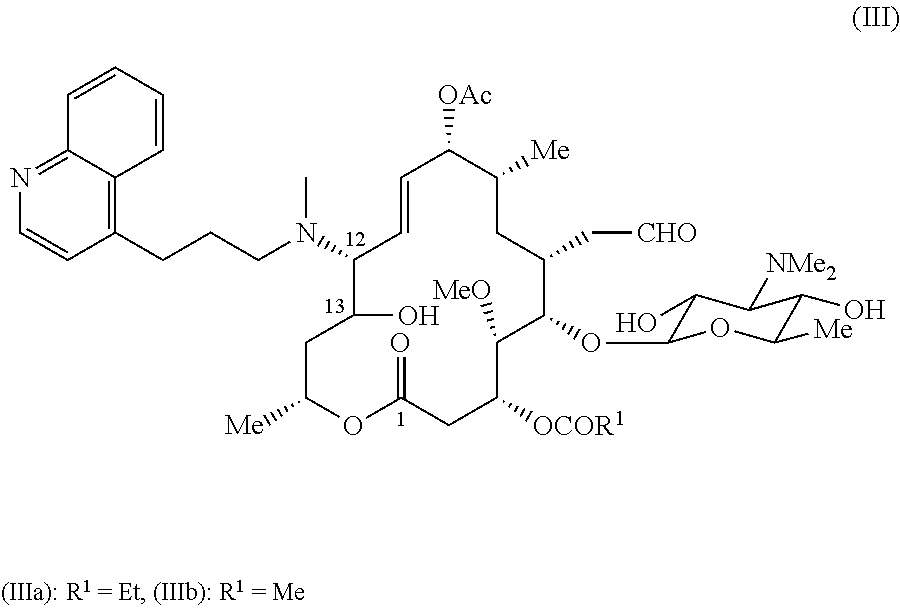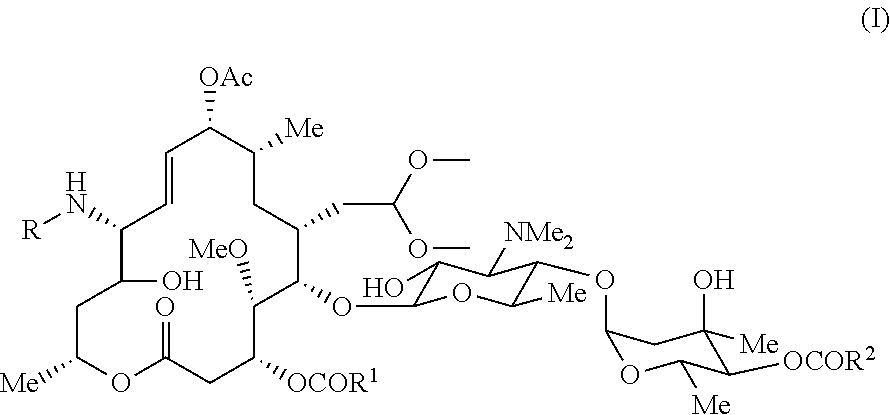Novel macrolide intermediate and novel production process
- Summary
- Abstract
- Description
- Claims
- Application Information
AI Technical Summary
Benefits of technology
Problems solved by technology
Method used
Image
Examples
example 1
[0046]Production method for 9-O-acetyl-12,13-dihydro-13-hydroxy-12-(N-methyl-N-(3-(quinolin-4-yl)propyl)aminomidecamycin 18-dimethylacetal ((Va); compound represented by the formula (V) where R1=R2=an ethyl group)
[0047]961 mg of 9-O-acetyl-12-azido-12,13-dihydro-13-hydroxymidecamycin 18-dimethylacetal, a compound obtained in accordance with a method disclosed in the patent literature (Example 3 in WO 2002 / 064607 A1), were dissolved by adding 24 ml of chloroform, and 2 ml of a 1 M solution of trimethylphosphine in toluene were added. The mixture was stirred at room temperature for 1 hour. 150 mg of paraformaldehyde were added, and the mixture was stirred for an additional 5 hours. Then, 189 mg of sodium borohydride were dissolved in 1 ml of methanol, and the resultant was gradually added. The mixture was stirred at room temperature for 30 minutes and concentrated under reduced pressure, and the resultant residue was purified by silica gel column chromatography (chloroform-methanol-aq...
example 2
Production method for 9-O-acetyl-4′-demycarosyl-12,13-dihydro-13-hydroxy-12-(N-methyl-N-(3-(quinolin-4-yl)propyl)aminomidecamycin (compound represented by the formula (IIIa))
[0053]60 mg of the compound of Example 1 were dissolved by adding 1 ml of acetonitrile, and 1 ml of water was added. 70 μl of difluoroacetic acid were added, and the mixture was stirred at 40° C. for 60 hours. To the reaction solution were added 20 ml of saturated aqueous sodium bicarbonate, and the resultant was extracted with 40 ml of ethyl acetate. The organic layer was washed successively with 20 ml of saturated aqueous sodium bicarbonate and 20 ml of brine. The resultant organic layer was dried over anhydrous sodium sulfate and then filtered. The filtrate was concentrated under reduced pressure. The resultant residue was purified by preparative TLC (chloroform-methanol-aqueous ammonia (100:10:1)) to afford 24 mg of the title compound.
Physicochemical Properties of this Compound
[0054](1) Mass spectrum (FAB): ...
example 3
[0056]Production method for 9-O-acetyl-12-azido-12,13-dihydro-13-hydroxyjosamycin 18-dimethylacetal (compound represented by the formula (IVb))
[0057]1.0 g of josamycin was dissolved in 15 μl of methylene chloride. To the solution were added 178 μl of pyridine, followed by gradual dropwise addition of 114 μl of acetyl chloride. The mixture was stirred at room temperature for 3 hours, and saturated aqueous sodium bicarbonate was then added. 35 ml of methylene chloride were added, and the resultant was washed successively with saturated aqueous sodium bicarbonate and brine. The organic layer was dried over anhydrous sodium sulfate and then filtered. The filtrate was evaporated under reduced pressure. The resultant concentrate was dissolved by adding 3 ml of methanol. To the solution were added 3 ml of methyl orthoformate and 322 mg of PPTS, and the mixture was stirred at 50° C. for 33 hours. To the reaction solution was added saturated aqueous sodium bicarbonate, and the mixture was co...
PUM
 Login to View More
Login to View More Abstract
Description
Claims
Application Information
 Login to View More
Login to View More - R&D
- Intellectual Property
- Life Sciences
- Materials
- Tech Scout
- Unparalleled Data Quality
- Higher Quality Content
- 60% Fewer Hallucinations
Browse by: Latest US Patents, China's latest patents, Technical Efficacy Thesaurus, Application Domain, Technology Topic, Popular Technical Reports.
© 2025 PatSnap. All rights reserved.Legal|Privacy policy|Modern Slavery Act Transparency Statement|Sitemap|About US| Contact US: help@patsnap.com



